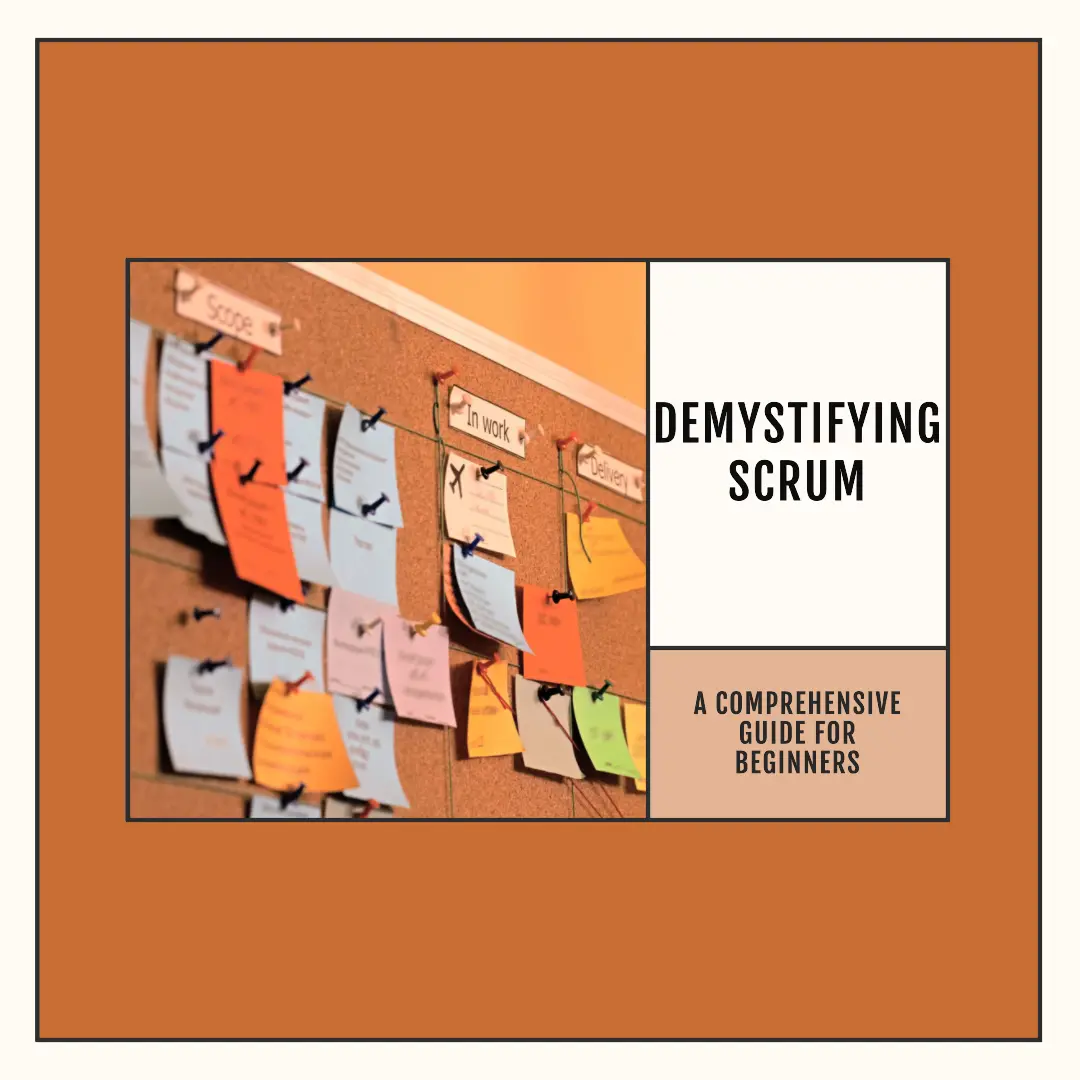I. Introduction
Hello, fellow project enthusiasts! If you’ve been searching for a way to streamline your project management processes and improve collaboration within your team, you’ve come to the right place. By now, you may have heard about Agile methodology and how it has transformed the project management landscape. But have you ever wondered what Scrum is and how it fits into the Agile world? That’s what we’re going to explore in this comprehensive guide for beginners.
A. Brief explanation of Agile methodology
But first, let’s take a quick look at the Agile methodology itself. Born out of frustration with traditional project management approaches like Waterfall, Agile focuses on delivering value to customers through iterative and incremental development. This means that instead of trying to plan every single detail upfront, Agile teams work in short cycles called iterations or sprints, and they continuously adapt to change based on feedback.
B. Importance of Scrum in Agile
Enter Scrum – one of the most popular Agile frameworks. Scrum is like the secret sauce that takes the Agile methodology to the next level. It provides a set of practices, roles, and artifacts that help teams efficiently implement Agile principles in their projects. Scrum has gained a massive following because it’s easy to understand, flexible, and can be applied to various industries and project sizes.
C. Purpose of the blog post
As a beginner, you might feel overwhelmed by the myriad of Scrum-related terms and concepts. Fret not! This blog post aims to demystify Scrum and guide you through its fundamentals, including its principles, roles, and artifacts. By the end of this post, you’ll have a solid understanding of how to implement Scrum in your projects and set your team up for success. So, grab a cup of coffee, sit back, and let’s dive into the wonderful world of Scrum!
II. Scrum Basics
A. Definition and origin of Scrum
Before we dive into the nitty-gritty of Scrum, let’s start by clarifying what it is and where it comes from. Scrum is a lightweight Agile project management framework that helps teams develop and deliver high-quality products iteratively and incrementally. Its name is inspired by the scrum formation in rugby, which symbolizes a team working closely together toward a common goal. Scrum was first introduced in the early 1990s by Jeff Sutherland and Ken Schwaber, who later formalized the framework in the Scrum Guide.
B. Scrum framework overview
At its core, Scrum is built around three pillars: transparency, inspection, and adaptation. The framework is designed to help teams break down complex projects into manageable chunks, prioritize tasks, and adapt to changes quickly. Scrum provides a set of roles, artifacts, and events that allow teams to effectively organize their work and deliver value to customers consistently.
C. Scrum principles
- Transparency: Transparency is key to making informed decisions and fostering trust within the Scrum team. All team members should have a clear understanding of the project’s progress, goals, and any potential obstacles. This is achieved by using shared artifacts like the Product Backlog and Sprint Backlog, as well as holding regular Scrum events.
- Inspection: Regular inspection of the work and the team’s performance ensures that the project stays on track and that the team continuously improves. Scrum events, such as Daily Scrums, Sprint Reviews, and Sprint Retrospectives, provide opportunities for the team to inspect their work and adapt accordingly.
- Adaptation: As the team inspects their work, they’ll inevitably identify areas for improvement and potential roadblocks. Scrum encourages teams to adapt quickly to change, whether it’s adjusting the project’s scope, refining processes, or tackling unforeseen challenges.
D. Benefits of using Scrum
You might be wondering, “What’s in it for me and my team?” Well, Scrum offers a plethora of benefits that can dramatically improve your team’s performance and overall project outcomes. Some of these benefits include:
- Faster time-to-market: By working in short iterations, teams can deliver valuable features to customers more quickly.
- Improved collaboration: Scrum promotes open communication and collaboration, ensuring that everyone is on the same page and working together effectively.
- Higher customer satisfaction: With regular feedback and adaptation, teams can better meet customer needs and deliver a product that truly delights.
- Increased flexibility: Scrum teams can quickly pivot and respond to changes, making them more resilient and better equipped to navigate uncertainty.
Now that we’ve covered the basics, let’s explore the roles, artifacts, and events that make up the Scrum framework.
III. Scrum Roles
One of the key aspects that sets Scrum apart is the clearly defined roles within the team. Each role has specific responsibilities and contributes to the overall success of the project. Let’s get to know the three main roles in a Scrum team: Product Owner, Scrum Master, and Development Team.
A. Product Owner
- Responsibilities: The Product Owner (PO) is like the captain of the ship, steering the project towards success. Their primary responsibility is to maximize the value of the product being developed. They achieve this by creating and managing the Product Backlog, prioritizing work items, and ensuring that the team focuses on the most valuable features. The PO also serves as the main point of contact between the team and stakeholders, gathering feedback and making informed decisions based on it.
- Characteristics of a good Product Owner: A great PO is decisive, has a clear vision for the product, and is an excellent communicator. They should have a deep understanding of customer needs and be able to prioritize tasks effectively. The best POs are also open to feedback, flexible, and able to make tough decisions when necessary.
B. Scrum Master
- Responsibilities: The Scrum Master is the team’s ultimate facilitator and coach, ensuring that the team follows Scrum practices and continuously improves. They help remove obstacles and create an environment where the team can thrive. Scrum Masters also work closely with the Product Owner to ensure that the Product Backlog is well-organized and that the team is always working on high-priority tasks.
- Characteristics of a good Scrum Master: A successful Scrum Master is a servant leader who is dedicated to the team’s success. They possess excellent communication and interpersonal skills, allowing them to foster collaboration and trust within the team. A great Scrum Master is also proactive in identifying and resolving issues, and they have a deep understanding of Scrum principles and practices.
C. Development Team
- Responsibilities: The Development Team is the group of skilled professionals responsible for delivering a high-quality product. They are cross-functional, meaning they possess all the necessary skills to complete the work, and self-organizing, taking ownership of their tasks and deciding how to best accomplish them. The Development Team collaborates closely with the Product Owner to understand requirements and provide estimates for completing tasks.
- Characteristics of a high-performing Development Team: A successful Development Team is collaborative, open to feedback, and committed to delivering high-quality work. They are adaptable, able to pivot when requirements change, and are continuously improving their skills and processes. Great Development Teams have a strong sense of accountability and take pride in their work.
With a solid understanding of the roles within a Scrum team, let’s explore the essential artifacts that help teams plan, track, and deliver their work.
IV. Scrum Artifacts
Scrum artifacts are essential tools that help teams plan, track, and manage their work throughout the project. These artifacts foster transparency and ensure that everyone on the team has a clear understanding of the project’s progress, goals, and any potential obstacles. Let’s delve into the three main Scrum artifacts: Product Backlog, Sprint Backlog, and Increment.
A. Product Backlog
- Definition and purpose: The Product Backlog is a living, ordered list of everything needed to be done to complete the project. It includes features, bug fixes, improvements, and any other work items necessary to achieve the project’s goals. The Product Backlog is owned and maintained by the Product Owner, who constantly updates and prioritizes items based on customer feedback, market changes, and stakeholder input.
- How to create and manage a Product Backlog: Creating a Product Backlog starts with defining user stories, which are simple, concise descriptions of a feature or requirement from the customer’s perspective. Each user story should include a description, acceptance criteria, and any relevant notes or attachments. The Product Owner prioritizes the user stories based on factors like value, risk, and dependencies. As the project evolves, the Product Owner continuously updates the Product Backlog, adding new items and refining existing ones to ensure that the team is always working on what’s most important.
B. Sprint Backlog
- Definition and purpose: The Sprint Backlog is a subset of the Product Backlog, containing a list of tasks that the Development Team commits to completing during a specific Sprint. The Sprint Backlog is dynamic and flexible, allowing the team to update it as they learn more about the work and encounter any challenges. The main purpose of the Sprint Backlog is to help the team focus on a specific set of tasks and track their progress throughout the Sprint.
- How to create and manage a Sprint Backlog: During the Sprint Planning event, the team selects high-priority items from the Product Backlog and moves them to the Sprint Backlog. The Development Team then breaks down these items into smaller tasks and estimates the effort required to complete them. As the team progresses through the Sprint, they update the Sprint Backlog, adding or removing tasks and marking completed items as “done.” This helps the team track their progress and adapt their plan as needed.
C. Increment
- Definition and purpose: The Increment is the sum of all completed Product Backlog items during a Sprint, combined with the value of previous Increments. The Increment represents the latest, potentially releasable version of the product. The purpose of the Increment is to provide a tangible measure of progress and ensure that the team is continuously delivering value to customers.
- Delivering increments and measuring progress: At the end of each Sprint, the team should have a potentially releasable Increment. During the Sprint Review, the team demonstrates the Increment to stakeholders, gathering feedback to inform future work. The team measures progress by tracking the completion of Product Backlog items and assessing the value delivered to customers. This helps the team understand their performance, identify areas for improvement, and plan for future Sprints.
Now that we’ve covered the crucial Scrum artifacts, let’s dive into the events that make up the Scrum framework and help teams effectively plan, inspect, and adapt their work.
V. Scrum Events
Scrum events, also known as Scrum ceremonies, are structured meetings that help teams plan, synchronize, inspect, and adapt their work. These events are time-boxed, meaning they have a predefined maximum duration, which encourages focused discussions and efficient use of time. Let’s explore the four main Scrum events: Sprint, Daily Scrum, Sprint Review, and Sprint Retrospective.
A. Sprint
- Definition and duration: A Sprint is a short, time-boxed period during which the Scrum Team works to complete a potentially releasable Increment of the product. Sprints typically last between 1 and 4 weeks, with the most common duration being 2 weeks. The goal is to have a consistent duration for each Sprint, allowing the team to establish a predictable rhythm.
- Goals and planning: Each Sprint starts with Sprint Planning, where the team collaborates to define the Sprint Goal and select the Product Backlog items they’ll work on during the Sprint. The Sprint Goal is a concise, shared objective that helps the team focus on delivering value. Throughout the Sprint, the team works on the tasks in the Sprint Backlog, collaborating and adapting their plan as needed to achieve the Sprint Goal.
B. Daily Scrum
- Purpose and structure: The Daily Scrum, sometimes called the daily stand-up, is a short, daily meeting where the Development Team synchronizes their work and plans for the next 24 hours. This 15-minute event is an opportunity for team members to share updates on their progress, discuss any obstacles, and coordinate their efforts. The Daily Scrum is not a status update for managers or stakeholders but rather a time for the team to collaborate and align.
- Tips for effective Daily Scrums: To make the most of your Daily Scrum, consider following these best practices:
- Keep it brief and focused: Stick to the 15-minute time-box and encourage team members to share concise updates.
- Use a consistent format: Many teams follow the “yesterday-today-blockers” format, where each member shares what they completed yesterday, what they plan to do today, and any obstacles they’re facing.
- Hold the meeting at the same time and place each day: This helps establish a routine and ensures that everyone knows when and where to attend.
- Foster a collaborative atmosphere: Encourage team members to ask for help, offer assistance, and discuss any challenges they’re facing.
C. Sprint Review
- Purpose and attendees: The Sprint Review is a collaborative event held at the end of each Sprint, where the Scrum Team and stakeholders review the Increment and discuss what to do next. The purpose of the Sprint Review is to gather feedback, assess the value delivered, and adapt the Product Backlog based on new insights. This event typically includes the Scrum Team, stakeholders, customers, and any other interested parties.
- Key activities during a Sprint Review: During the Sprint Review, the team typically:
- Demonstrates the Increment: The Development Team shows the completed work and explains how it meets the Sprint Goal.
- Discusses the work: Stakeholders and team members discuss the Increment, ask questions, and provide feedback.
- Reviews the Product Backlog: The Product Owner discusses any updates to the Product Backlog and presents the proposed plan for the next Sprint.
- Adapts the plan: Based on the feedback and discussion, the team collaborates to adjust the Product Backlog and plan for the next Sprint.
D. Sprint Retrospective
- Purpose and structure: The Sprint Retrospective is a team event held after the Sprint Review, where the Scrum Team reflects on the past Sprint and identifies opportunities for improvement. The purpose of the Sprint Retrospective is to promote continuous learning and improvement, helping the team fine-tune their processes and collaboration. This event usually lasts between 1 and 3 hours, depending on the Sprint length and the team’s needs.
- Key activities during a Sprint Retrospective: During the Sprint Retrospective, the team typically:
- Reflects on the Sprint: Team members share their thoughts on what went well, what could be improved, and any lessons learned during the Sprint.
- Identifies improvement opportunities: The team collaborates to identify specific areas for improvement, such as communication, processes, or tools.
- Develops an action plan: Together, the team creates a plan to address the identified improvement opportunities, assigning responsibility for implementing changes and setting deadlines.
- Commits to improvement: The team commits to implementing the agreed-upon changes during the next Sprint, continually refining their approach and performance.
- Tips for effective Sprint Retrospectives: To make the most of your Sprint Retrospectives, consider the following best practices:
- Create a safe and open environment: Encourage team members to share their thoughts honestly and respectfully, fostering a culture of trust and continuous improvement.
- Use a structured format: Following a specific format or using retrospective techniques, like the “Start-Stop-Continue” or “Mad-Sad-Glad” methods, can help guide the discussion and keep it focused.
- Prioritize action items: Instead of trying to tackle every improvement opportunity at once, focus on the most critical issues and create a manageable action plan.
- Follow up on commitments: Ensure that the team follows through on their commitments by reviewing the progress of action items during the next Sprint Retrospective.
With a solid grasp of the Scrum roles, artifacts, and events, you’re now ready to embark on your journey towards implementing Scrum in your projects. Remember, Scrum is an adaptable framework that requires continuous learning and improvement, so stay open to feedback and embrace change as you and your team grow. Happy Scrumming!
VI. Implementing Scrum
Embarking on the Scrum journey can be both exciting and challenging, but the rewards are well worth the effort. To help you get started, let’s explore some crucial steps and best practices for implementing Scrum in your organization.
A. Assessing your organization’s readiness for Scrum
- Evaluate your current processes: Before diving into Scrum, take a moment to assess your current project management processes. Consider what’s working, what’s not, and where you might encounter resistance when adopting Scrum.
- Identify potential challenges: Recognize any organizational barriers, such as rigid hierarchies or a lack of collaboration, that could hinder Scrum adoption. Consider how you’ll address these challenges and gain buy-in from stakeholders.
- Assess your team’s mindset: Embracing Scrum requires a shift in mindset, from focusing on individual tasks to collaborating as a team. Gauge your team’s openness to change and their willingness to adopt new ways of working.
B. Building a Scrum team
- Assemble a cross-functional team: A successful Scrum team includes members with diverse skills and expertise. Ensure your team has all the necessary competencies to deliver a high-quality product, from development and design to testing and deployment.
- Define Scrum roles: Clearly define and assign the roles of Product Owner, Scrum Master, and Development Team members. Ensure that each person understands their responsibilities and is committed to fulfilling their role.
- Foster a collaborative culture: Encourage open communication, mutual respect, and trust within your team. Establish an environment where team members feel safe to share ideas, ask for help, and hold each other accountable.
C. Transitioning from traditional project management to Scrum
- Educate and train: Ensure that your team has a solid understanding of Scrum principles and practices. Provide training, workshops, or coaching to help your team members gain the knowledge and skills they need to succeed with Scrum.
- Start small and iterate: When adopting Scrum, it’s often helpful to start with a small project or pilot program. This allows your team to gain experience and confidence with Scrum before scaling it up to larger projects.
- Adapt and refine: As you transition to Scrum, be prepared to encounter challenges and learn from them. Continuously inspect and adapt your processes, adjusting your approach based on feedback and lessons learned.
D. Best practices for adopting Scrum
- Embrace change and continuous improvement: Remember that Scrum is an adaptable framework that requires ongoing learning and refinement. Foster a culture of continuous improvement and encourage your team to regularly reflect on their performance and processes.
- Maintain transparency and open communication: Ensure that your team’s progress, goals, and obstacles are visible to all team members and stakeholders. This fosters accountability, collaboration, and a shared understanding of the project’s status.
- Set realistic expectations: Be patient and realistic with your expectations when adopting Scrum. Remember that it takes time for teams to adjust to new ways of working and to realize the full benefits of Scrum.
- Celebrate successes and learn from failures: Acknowledge and celebrate your team’s achievements as they progress with Scrum. At the same time, treat failures as learning opportunities that can help your team grow and improve.
By following these steps and best practices, you’ll be well on your way to successfully implementing Scrum in your organization. Embrace the journey, stay open to feedback, and enjoy the many benefits that Scrum can bring to your projects and teams.
VII. Conclusion
As we reach the end of our comprehensive guide to Scrum, let’s take a moment to recap the key takeaways and offer some encouragement as you embark on your journey to implementing Scrum in your projects.
A. Recap of key takeaways
- Scrum is an Agile framework that enables teams to deliver high-quality products iteratively and incrementally, adapting to change and continuously improving.
- The three primary roles in Scrum are the Product Owner, Scrum Master, and Development Team, each with their own distinct responsibilities.
- Scrum artifacts, such as the Product Backlog, Sprint Backlog, and Increment, help teams plan, track, and manage their work throughout the project.
- Scrum events, including the Sprint, Daily Scrum, Sprint Review, and Sprint Retrospective, provide structured opportunities for teams to plan, synchronize, inspect, and adapt their work.
- Implementing Scrum requires assessing your organization’s readiness, building a cross-functional team, transitioning from traditional project management, and following best practices for adoption.
B. Encouragement to start implementing Scrum in projects
As you venture into the world of Scrum, remember that adopting this framework is a journey, not a destination. Embrace the spirit of continuous learning and improvement, and stay open to feedback from your team and stakeholders.
Don’t be afraid to start small and iterate as you go. As your team becomes more comfortable with Scrum, you’ll likely see improvements in collaboration, adaptability, and overall project success. The benefits of Scrum can be transformative, not only for your projects but also for your entire organization.
So, what are you waiting for? It’s time to dive in, put these principles into practice, and experience the power of Scrum for yourself. We wish you the best of luck on your Scrum journey and can’t wait to hear about the incredible results you’ll achieve along the way!
To find out how Artificial Intelligence is changing the Project Management landscape, you have enjoy reading this article https://www.shaunstoltz.com/did-artificial-intelligence-just-change-everything-about-project-management/
Find out more about Shaun Stoltz https://www.shaunstoltz.com/about/
This post was written by an AI and reviewed/edited by a human.



